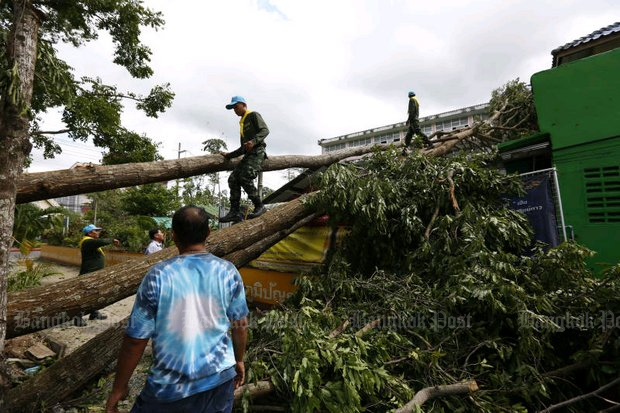
When reports of tropical storm Pabuk first emerged, there were initial concerns that it could become a repeat of tropical storm Harriet, which killed roughly 900 people in 1962, or killer Typhoon Gay which caused 833 deaths in 1989.
There was good reason to be worried. Since the devastating Indian Ocean tsunami of 2004, Thailand has witnessed over 85 disasters of varying magnitudes, resulting in the deaths of 2,750 people and affecting over 63 million people. Floods have been the most frequent disaster, accounting for over two-thirds of the disaster-induced mortality and half of the affected population.
Fortunately, that was not the case this time. Pabuk, which struck southern Thailand early this month, passed with minimal loss of life thanks to the early actions of Thai authorities, including evacuating at-risk populations. Thailand, like other countries in the region, has been consistently and significantly strengthening its capacity to react early to impending threats of hazards. This investment in early warning systems plays a critical role when disasters strike and accounts for a major decrease throughout the region in mortality and morbidity.
Tropical storm Pabuk, however, caused considerable damage. The most affected areas in southern Thailand struggled with flooding, uprooted trees, and downed electric poles. Moreover, since the storm struck during the peak tourism season, it threatened the livelihoods of thousands who depend on income from tourism and disrupted the vacations of thousands of tourists. The ensuing result was tremendous economic losses.
Throughout the Asia-Pacific region, due to climate change, extreme weather events are becoming increasingly unpredictable in their frequency and intensity. Indeed, Pabuk was the first tropical cyclone to hit Thailand in the months between January and March. While one anomaly is not enough to make a trend, there is increased concern in the region that such unpredictable weather patterns will impact a country's ability to prepare for, and respond effectively to weather-related hazards.
This concern is supported by newly released disaster loss figures from the global reinsurer Munich Re, which states that "From a global perspective, the 2018 cyclone season will be seen as statistically unusual" and notes that 2018 had a "greater frequency of unusual loss events". This could be a harbinger of future cyclone seasons, underscoring the need for ongoing investment in early warning and early action.
The Asia-Pacific region suffered several notable and unusual disasters in 2018. Indonesia suffered its deadliest year due to disasters since 2007, according to BNPB, the National Disaster Mitigation Agency, with at least 4,231 people dead or declared missing. Japan was hit by two earthquakes and a number of typhoons, including Typhoon Jebi. In India, the state of Kerala experienced the worst floods since 1924. The torrential rains triggered several landslides, which along with the floods, affected 5.4 million people, displaced 1.4 million people, and took 433 lives, according to the Asian Development Bank.
What all these disasters have in common is that they demonstrate that countries stand a better chance of minimising their impact if they have put in place effective disaster risk reduction measures. Increasingly, investing in disaster risk reduction is a pre-condition for achieving sustainable development in a world with a changing climate. This includes making development decisions that take into account and prevent risk, setting up early warning systems that can detect a variety of hazards, educating the public on disaster risks, and investing in building resilient infrastructure that can withstand shocks.
Building resilient infrastructure does not just apply to public roads, bridges and dams, but also to schools, hospitals, and critical facilities. These basic service facilities play an important role in recovery and rehabilitation efforts after a disaster. That is why the Sendai Framework for Disaster Risk Reduction, a global agreement adopted in 2015, designates the strengthening of their resilience as a distinct target to be achieved by countries. Notably, tropical storm Pabuk damaged several hospitals and schools, thereby reducing essential services for the community. Recovery efforts must ensure that these facilities are repaired and rebuilt in a manner which allows them to withstand the impact of future storms.
To maximise the use of limited resources, it is critical that investments towards resilience be targeted in a calculated manner. Communities need to understand the risks they face and prioritise actions to address these risks. This includes understanding which groups are most vulnerable and most likely to be negatively impacted by a hazard such as a cyclone or flood. The knowledge gained from such assessments must be used to guide development decisions thereby ensuring that major development decisions and urban planning are risk-informed and do no create new risk. This will help protect development gains from being washed away by an avoidable disaster.
A key method of integrating risk knowledge into government programmes is the development of a sound national disaster risk reduction strategy. Currently, about half of the countries in the Asia-Pacific region have developed such strategies. The Thai government is conducting a national workshop, with the support of UNISDR to revise their National Disaster Risk Management Plan so that it focuses more on understanding and managing risk, rather than simply responding to disasters.
Having a national disaster risk reduction strategy is critical to informing how a country safeguards its cities and inoculates investments against future losses. An inclusive strategy also ensures that all relevant stakeholders are involved, especially those who are most negatively impacted by disasters, such as the poor, women and girls, and persons living with disabilities. Ultimately investment in risk reduction aims to ensure that all members of society, especially the most vulnerable, are protected from the most negative effects of disasters.
The manner in which Thai authorities responded to the impending impact of tropical storm Pabuk provides an excellent example of disaster risk reduction in action and may serve as an example to other countries facing unpredictable extreme weather events that could result in a disastrous outcome for thousands of people.
Loretta Hieber Girardet, Chief of the UNISDR Regional Office for Asia and the Pacific.